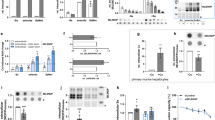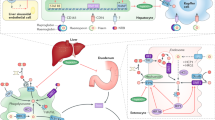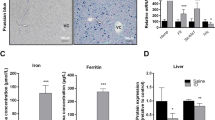Abstract
THE relationship of liver proteins to the metabolism of copper in the mammalian organism is poorly understood. The cuproprotein engaging the attention of most investigators is ceruloplasmin, which seems to be synthesized in the liver1,2, although its serum concentration is the parameter measured in various physiological and disease states. Other hepatic proteins or enzyme systems have been suggested to be involved in the uptake of copper from the plasma and its incorporation into ceruloplasmin3,4; in the storage of copper in the developing foetus5—in the adult when abnormal amounts of copper enter the organism3,6 or in patients with hepatolenticular degeneration7; and in the transport of copper within the liver cell8. The predilection of copper for binding to proteins8 suggests that this process is important in the metabolism of the metal in the liver, for example, in the maintenance of neutral copper balance after early postnatal growth. If so, interference with protein synthesis could then be expected to result in an altered ability of the liver to retain copper. This hypothesis was tested in subacute experiments by treating rats with copper sulphate and with inhibitors of protein synthesis.
This is a preview of subscription content, access via your institution
Access options
Subscribe to this journal
Receive 51 print issues and online access
$199.00 per year
only $3.90 per issue
Buy this article
- Purchase on Springer Link
- Instant access to full article PDF
Prices may be subject to local taxes which are calculated during checkout
Similar content being viewed by others
References
Lang, N., and Renschler, H. E., Z. Ges. Exp. Med., 130, 203 (1958).
Owen, jun., C. A., and Hazelrig, J. B., Amer. J. Physiol., 210, 1059 (1966).
Hazelrig, J. B., Owen, jun., C. A., and Ackerman, E., Amer. J. Physiol., 211, 1075 (1966).
Osborn, S. B., and Walshe, J. M., Lancet, i, 346 (1967).
Porter, H., Sweeney, M., and Porter, E., Arch. Biochem. Biophys., 104, 97 (1964).
Porter, H., in The Biochemistry of Copper (edit. by Peisach, J., Aisen, P., and Blumberg, W. E.), 167 (Academic Press, New York, 1966).
Porter, H., Arch. Neurol., 11, 341 (1964).
Sass-Kortsak, A., Adv. Clin. Chem., 8, 1 (1965).
Shull, K. H., J. Biol. Chem., 237, PC1734 (1962).
Gregoriadis, G., and Sourkes, T. L., Canad. J. Biochem., 45, 1841 (1967).
Reinhold, J. G., Kfoury, G. A., and Thomas, T. A., J. Nutrit., 92, 173 (1967).
Scheuer, P. J., and Barka, T., Nature, 201, 1135 (1964).
Mann, T., and Keilin, D., Proc. Roy. Soc., B, 126, 303 (1939).
Mohamed, M. S., and Greenberg, D. M., J. Gen. Physiol., 37, 433 (1954).
Morell, A. G., Shapiro, J. R., and Scheinberg, I. H., in Wilson's Disease, Some Current Concepts (edit. by Walshe, J. M., and Cumings, J. N.) (C. C. Thomas, Springfield, Illinois, 1961).
Sourkes, T. L., Lloyd, K., and Birnbaum, H., Canad. J. Biochem., 46, 267 (1968).
Author information
Authors and Affiliations
Rights and permissions
About this article
Cite this article
GREGORIADIS, G., SOURKES, T. Role of Protein in Removal of Copper from the Liver. Nature 218, 290–291 (1968). https://doi.org/10.1038/218290a0
Received:
Revised:
Issue Date:
DOI: https://doi.org/10.1038/218290a0
This article is cited by
-
Fe- und Cu-Gehalte in Leber, Milz, Niere und Herz wachsender Ratten bei unterschiedlicher Fe- und Cu-Versorgung
Zeitschrift für Ernährungswissenschaft (1983)
Comments
By submitting a comment you agree to abide by our Terms and Community Guidelines. If you find something abusive or that does not comply with our terms or guidelines please flag it as inappropriate.



